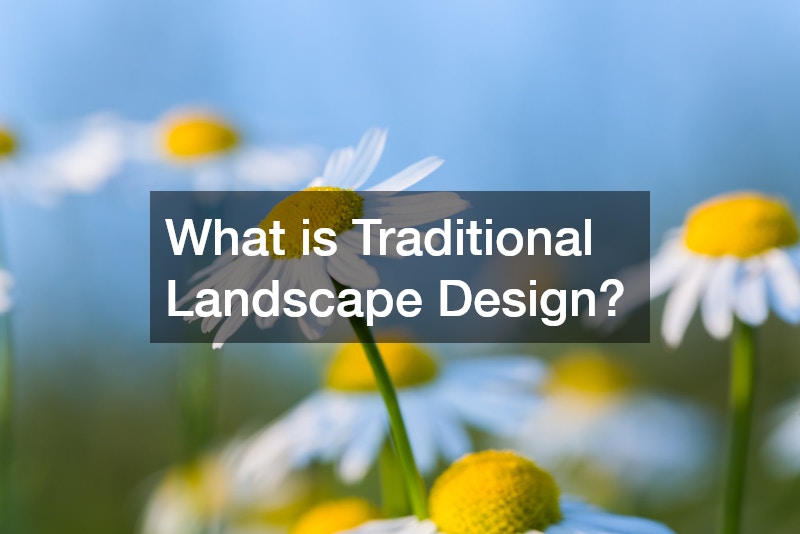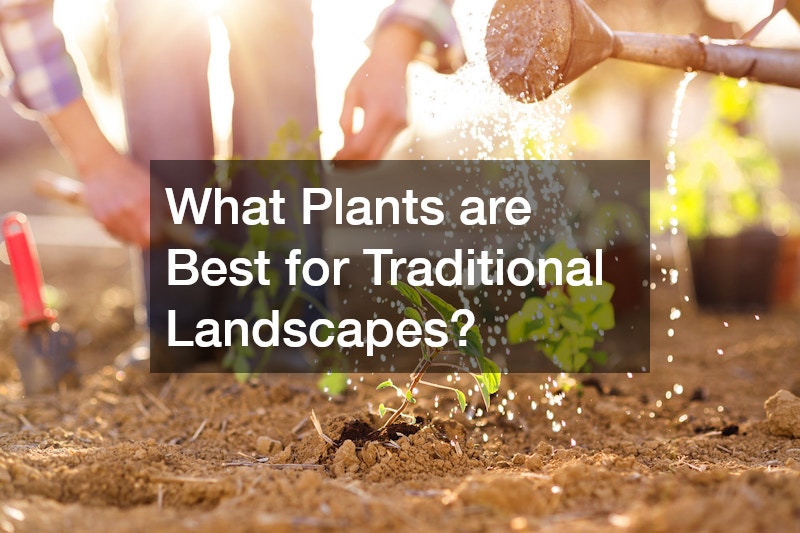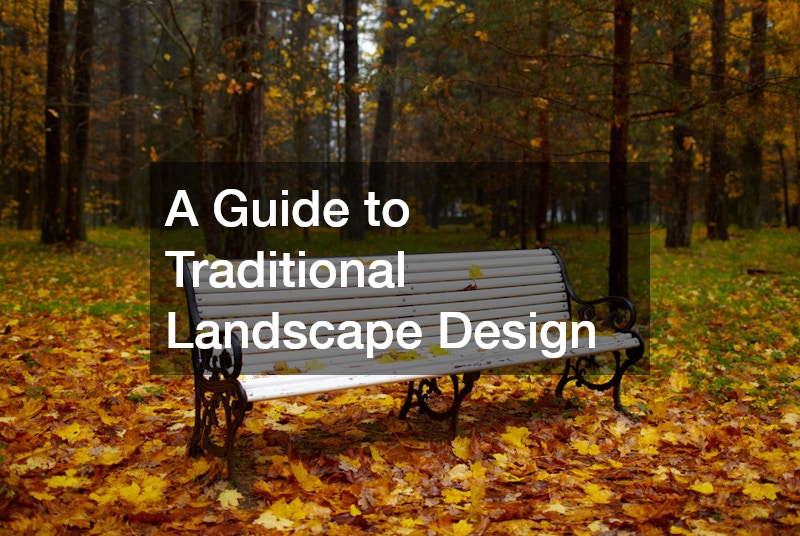Traditional landscape design stands as a timeless approach to outdoor aesthetics, rooted in classical principles and nurtured through centuries of refinement. Drawing inspiration from European gardens, colonial American yards, and other historical landscapes, traditional garden design blends symmetry, order, and natural beauty. Its appeal lies in its ability to harmonize structure with lushness, creating spaces that feel both grand and inviting. Whether you’re working with a local landscaping service or planning a do-it-yourself project, this guide delves into the fundamentals of traditional landscaping, including lighting, plant selection, hardscape elements, and more, to help you cultivate a classic and enduring garden.
What is Traditional Landscape Design?

Definition and Overview
Traditional landscape design emphasizes balance, symmetry, and formality. It often mirrors the architecture of the home, using natural elements and design features to create a cohesive, orderly appearance. Curved pathways, clipped hedges, and geometrically shaped flower beds are hallmark features. The design prioritizes unity and repetition, creating visually pleasing spaces that evoke tranquility and order. Working with a professional landscaper can ensure these principles are executed with expertise.
Historical Context and Development
The roots of traditional landscape design can be traced back to the grand gardens of Europe, especially in countries like England, France, and Italy. The Renaissance and Baroque periods inspired the symmetrical, formal gardens found in estates and palaces. Over time, these principles crossed the Atlantic and were adopted in early American gardens, especially in colonial and federal styles. Today, many lawn care companies and landscape lighting experts reference these classical styles when designing outdoor spaces that reflect historic elegance.
Key Characteristics of Traditional Landscapes
Key features include axial alignments, formal planting beds, clipped boxwood hedges, and central focal points like fountains or statues. Trees and shrubs are often pruned to maintain a structured form. Plant palettes tend to be restrained and harmonious, favoring greens, whites, pastels, and blooms in deliberate repetition. Elements such as accent stones, decorative rock, and retaining wall paving also serve as both functional and aesthetic components.
Differences from Modern Design
While modern landscape design embraces minimalism, asymmetry, and organic shapes, traditional design adheres to symmetry, structure, and historical motifs. Modern gardens might prioritize sustainability and native plantings, whereas traditional designs lean into curated beauty and classical elegance. Despite these differences, many contemporary hardscapers and designers are skilled at blending both styles to achieve a timeless yet functional space.
Benefits of Traditional Landscapes
Traditional gardens offer enduring beauty and a sense of timelessness. Their structured nature makes maintenance more predictable, and their emphasis on quality materials ensures long-lasting appeal. These gardens also complement historical or classically styled homes, enhancing property value and curb appeal. Partnering with a local landscaping service or reputable lawn care company ensures these benefits are fully realized through expert maintenance and installation.
How to Plan a Traditional Landscape?
Assessing Your Space
Begin by thoroughly evaluating your outdoor area. Take measurements, note existing features, and observe sun and shade patterns. Consider views from inside your home and how people will move through the space. Enlisting a professional landscaper at this stage can help with accurate site analysis and maximize the functionality of your garden layout.
Designing a Layout
A successful traditional landscape hinges on symmetry and balance. Lay out your garden using axial lines—central paths or sightlines that guide the eye to focal points like statues, fountains, or specimen trees. Incorporating retaining wall paving and decorative rock elements can help define these axes and control elevation changes.
Selecting Plant Materials
Choose plants that support the traditional aesthetic. Evergreens provide structure year-round, while perennials and flowering shrubs add seasonal interest. Roses, hydrangeas, peonies, and lavender are classic selections. Many tree companies offer planting and pruning services for ornamental and shade trees that fit within a traditional style.
Integrating Hardscape Elements
Paths, patios, and walls are essential in traditional gardens. Use materials like brick, natural stone, or cobblestones to maintain authenticity. Features such as accent stones, decorative rock, and crafted retaining walls add texture and enhance the structure of the space. Hiring a skilled hardscaper ensures these elements are installed with both durability and style in mind.
Creating a Cohesive Aesthetic
All elements—from plants to hardscape to furnishings—should speak the same design language. Use repetition and symmetry to reinforce the traditional style. For consistent plant health and color, consult lawn care companies that offer maintenance plans including pruning, fertilization, and weed control.
What Plants are Best for Traditional Landscapes?

Native vs. Non-Native Species
While traditional gardens often incorporate classic non-native plants such as boxwoods or English roses, integrating native plants can improve sustainability and reduce maintenance. Native species adapted to your local climate will thrive with less care, support local wildlife, and resist pests and diseases more effectively.
Popular Flower Choices
Roses, tulips, lilies, irises, and peonies are staples in traditional gardens. These flowers offer vibrant color, elegant form, and historical resonance. Seasonal blooms like daffodils in spring or chrysanthemums in fall add interest throughout the year. Irrigation systems help maintain optimal moisture levels, ensuring consistent blooming and healthy growth.
Essential Shrubs and Trees
Boxwoods, hollies, yews, and hydrangeas are popular shrubs for structure and formality. Trees like magnolias, dogwoods, and oaks provide shade and vertical interest. Partnering with a certified tree company guarantees proper tree selection, planting, and long-term care.
Seasonality and Plant Selection
Select plants to ensure blooms and visual interest throughout the seasons. Plan for a spring flush of color, a summer of lush greens and pastels, fall foliage, and winter structure through evergreens and hardscape elements. Irrigation systems can be zoned to accommodate the differing water needs of seasonal plants.
Maintaining a Traditional Plant Palette
Stick with a restrained color scheme and consistent plant types. Repetition creates rhythm and harmony. Avoid overly exotic or out-of-place plant species that may clash with the overall look. Lawn care companies often provide services to help maintain plant health and adherence to the original design.
How to Incorporate Water Features?
Types of Water Features
Fountains, birdbaths, reflecting pools, and small ponds are common in traditional landscapes. Tiered fountains made of stone or cast iron evoke European grandeur, while simpler birdbaths can provide charm and functionality. Reflecting pools offer elegance and symmetry, particularly when placed along central axes.
The Role of Water in Traditional Design
Water brings life, sound, and movement to the garden. It creates focal points, cools the atmosphere, and invites wildlife. In traditional design, water features are often central elements, placed where they can be viewed from multiple angles, enhancing the sense of balance and serenity.
Designing Decorative Water Elements
Choose classic materials like stone, copper, or cast iron. Surround the feature with structured plantings, accent stones, or decorative rock for a natural yet formal appearance. Irrigation systems should be carefully designed to complement water features without overwhelming them.
Water Feature Maintenance
Regular cleaning, checking pumps and filtration systems, and managing algae are essential for maintaining beauty and function. A landscaper or local landscaping service can perform seasonal maintenance to ensure water features operate smoothly and look their best year-round.
Enhancing Ambiance with Water Sounds
The gentle trickle of a fountain or the bubbling of a small stream adds an auditory layer to the garden experience. These sounds mask street noise, promote relaxation, and enhance the sensory appeal of your landscape.
What Hardscape Elements are Common?

Pathways and Walkways
Curved or straight paths made of brick, flagstone, or cobblestone guide visitors through the garden. Edging them with decorative rock or low-growing perennials adds interest and maintains a polished look. A hardscaper can help design and install these elements with precision.
Patios and Seating Areas
A well-designed patio offers a peaceful space for relaxation and entertaining. Use natural materials to match the overall design and position the space to capture views of the garden. Include classical furniture and consider surrounding the area with structured planting beds or accent stones for definition.
Garden Walls and Fences
Low stone walls and wrought iron or wood fences provide structure and privacy. They define boundaries while maintaining an open, welcoming feel. Adding a retaining wall where needed ensures stability in sloped areas and enhances the aesthetic.
Arbors and Trellises
These vertical elements offer opportunities for climbing plants like roses and clematis. A well-placed arbor at the garden’s entrance or along a pathway creates a charming, classical ambiance.
Stone Features and Sculptures
Classical statues, urns, sundials, and decorative rock accents create visual interest and reflect timeless style. Proper installation by a landscaper ensures these pieces are positioned for maximum effect and stability.
How to Maintain a Traditional Landscape?
Regular Pruning and Trimming
Structured gardens require frequent upkeep to maintain clean lines and healthy plants. Regular pruning is best performed by a tree company or lawn care professionals who understand the needs of each species.
Seasonal Clean-Up
Each season brings new maintenance tasks—clearing fallen leaves, preparing beds, or refreshing mulch. A local landscaping service can manage these chores, keeping your garden looking refined and tidy.
Pest and Disease Management
Integrated pest management (IPM) strategies reduce chemical use while protecting plant health. Lawn care companies often include pest control as part of their comprehensive service packages.
Fertilization Techniques
Balanced fertilization supports plant vigor and bloom production. Professionals can test soil and tailor nutrient programs for optimal results.
Irrigation Best Practices
Modern irrigation systems can be automated and zoned to provide appropriate water levels for different garden sections. Smart technology helps conserve water while ensuring healthy plants.
How to Incorporate Color in Traditional Landscapes?
Understanding Color Schemes
Use subtle, harmonious color palettes that include whites, blues, purples, and greens. Let accent stones and evergreen hedges serve as a visual backdrop to seasonal floral highlights.
Seasonal Flower Arrangements
Choose plants that offer seasonal blooms and rotate them for visual interest. Working with a landscaper ensures that new plantings fit your garden’s established aesthetic and thrive in your soil and climate.
Balancing Greenery with Color
Evergreens offer year-round structure, allowing colorful blooms to pop without overwhelming the eye. Irrigation systems keep all plants healthy and vibrant, supporting lush foliage and vibrant blossoms.
The Role of Accent Plants
Accent plants—those with unusual color, texture, or shape—should be placed strategically to draw the eye to focal points, such as near water features or sculptures.
Color Timing for Year-Round Interest
Plan your planting calendar so something is always in bloom. A mix of bulbs, perennials, and flowering shrubs keeps the garden dynamic and engaging.
How to Choose the Right Furniture for a Traditional Garden?
Material Considerations
Opt for timeless materials such as wrought iron, stone, or hardwood. These materials are durable and age gracefully, blending well with retaining wall paving, stone paths, and classic architectural features.
Style and Comfort
Furniture should reflect the garden’s formal style but still be comfortable. Look for elegant lines and traditional silhouettes.
Placement and Space Utilization
Place benches and seating areas along paths, near water features, or within flower beds. Let the natural layout and symmetry guide furniture placement.
Weather Resistance and Durability
Choose high-quality, weather-resistant furniture. Regular maintenance, like sealing or covering, extends the life of these investments.
Maintenance and Care
Clean and treat outdoor furniture regularly. Use products suited to your material, and store cushions during harsh weather.
What Role Does Lighting Play in Traditional Landscapes?
Importance of Lighting in Landscape Design
Landscape lighting extends usability into the evening and enhances the atmosphere. It also ensures safety by illuminating paths, steps, and dark corners.
Types of Lighting Solutions
Choose classical-style fixtures that blend with the garden’s theme. Lanterns, bollard lights, and wall sconces are common choices for traditional gardens.
Designing with Pathway Lights
Path lights should be spaced evenly to provide visibility without overwhelming the natural ambiance. A landscaper can help position lights to highlight symmetry and key features.
Accent and Uplighting Techniques
Use uplighting on trees or statues to create dramatic night-time effects. Accent lighting draws attention to flower beds, decorative rock arrangements, or water features.
Energy-Efficient Lighting Options
Solar and LED options reduce energy use without sacrificing brightness or style. Many modern fixtures come in vintage designs that match traditional aesthetics.
How to Personalize a Traditional Landscape?

Adding Personal Touches
Incorporate features like a monogrammed bench, custom gate, or family-favorite plants. These subtle additions make the garden feel uniquely yours.
Incorporating Art and Statues
Use sculptures, urns, or wall art that reflect your interests or heritage. Position them thoughtfully for visual impact.
Customizing Plant Selections
Add plants with sentimental or cultural significance. Use irrigation systems to support more delicate species that need careful watering.
Creating Unique Garden Features
Install a rose tunnel, herb parterre, or meditation nook. Let your personality influence these spaces, while maintaining overall harmony.
Aligning with Personal History or Culture
Reflect your family’s heritage with design elements, such as Mediterranean plantings, Asian-style rock arrangements, or native North American flowers.
Traditional landscape design is more than a stylistic choice—it’s a celebration of timeless beauty, thoughtful structure, and harmonious balance. Whether you’re enhancing curb appeal, restoring a historic home, or simply longing for a refined outdoor sanctuary, traditional landscaping offers the tools to craft a space that’s both elegant and enduring. By partnering with skilled landscapers, lawn care companies, hardscapers, tree companies, and local landscaping services, and by integrating essential features like irrigation systems, retaining wall paving, decorative rock, and landscape lighting, you can create a garden that feels as fresh today as it would have centuries ago.



